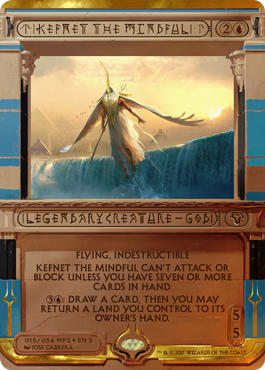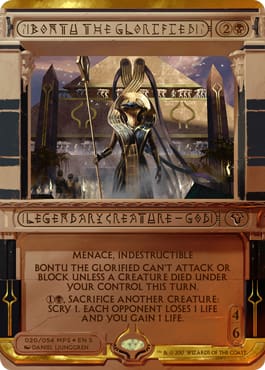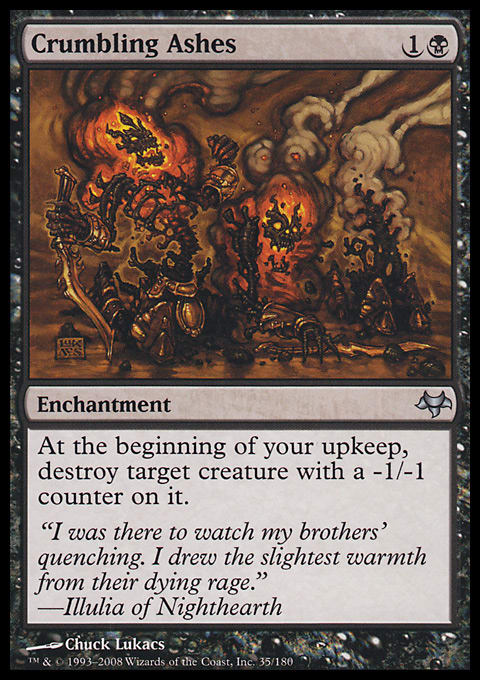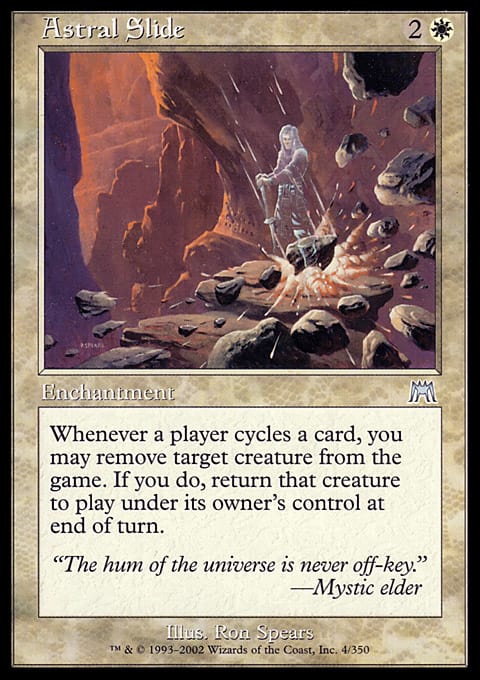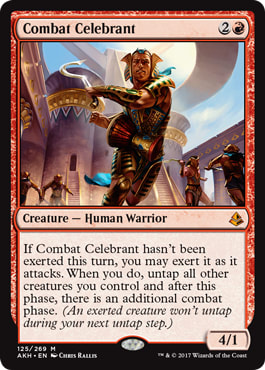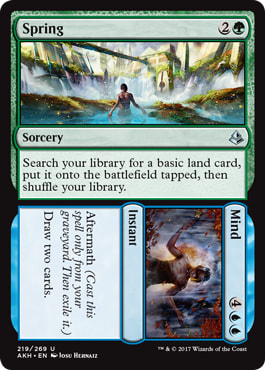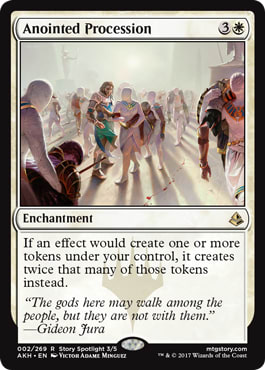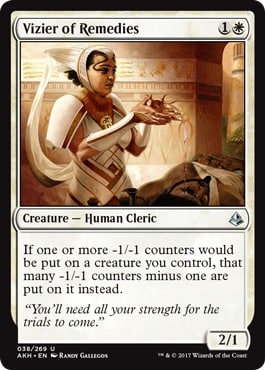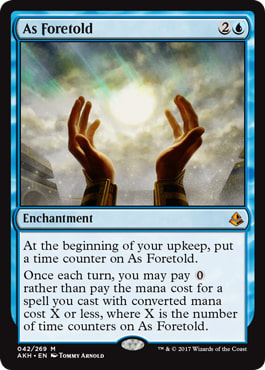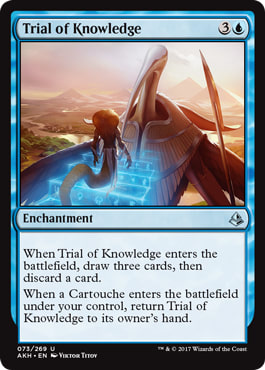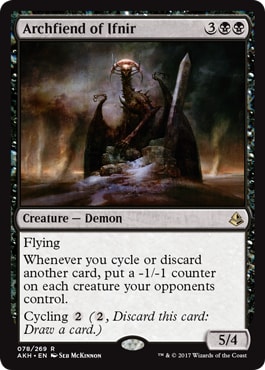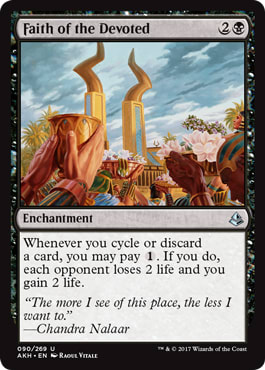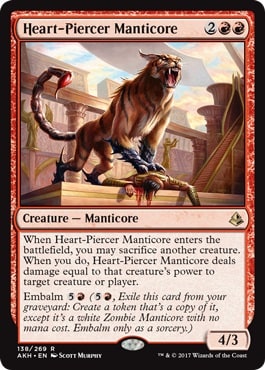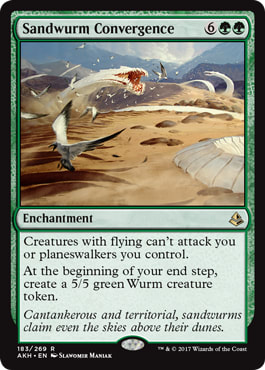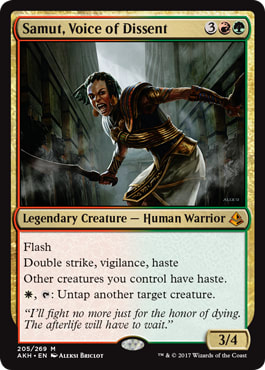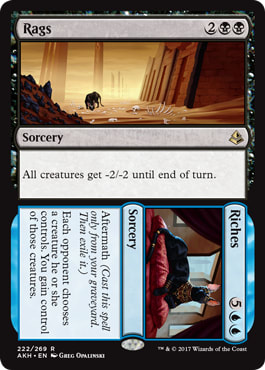I don’t normally do set reviews, but Amonkhet has everything a casual player could want: Full-art lands! Gods! Cool new mechanics! Cool old mechanics! Tricolor gods . . . well, not so much, but with all this goodness, we can let some things slide.
Oh My Gods
A new cycle of mono-colored gods is a great place to start, especially (but not exclusively) for the Commander crowd. They have simplified the god mechanic from Theros — they are no longer enchantments, and they're always creatures, but you have to jump through certain hoops to attack or block with them. This means they still have to be turned on (phrasing) like the Theros block ones, but they all have abilities that help them to meet their own activation criteria. Let’s go down the list:
- Oketra the True can't attack or block unless you control at least three other creatures, but she can generate duder tokens.
- Kefnet the Mindful can't attack or block unless you have seven or more cards in hand, but his ability lets you draw and bounce a land, bumping your hand size by up to two with each activation
- Bontu the Glorified can't attack or block unless a creature you control has died this turn, but you’re playing black and she has a nifty sacrifice ability.
- Hazoret the Fervent can't attack or block unless you have one or fewer cards in hand, but his activated ability allows you to discard for fun and prophet.
- Rhonas the Indomitable can't attack or block unless you control another creature with power four or greater, but if you have another creature he can pump it up until it meets that criteria.
None of these are particularly difficult to achieve—Rhonas and Oketra seem like the easiest, Hazoret or maybe Kefnet are the hardest, and Bontu is somewhere in the middle, but all of them are easily Johnnyable. 1 Some of you will be disappointed that the new gods are always creatures, making them easier to remove. Personally, I’m thrilled that they're always creatures, making them easier to remove. I’ve often struggled to deal with Theros gods, mainly because Black lacks enchantment removal; their being indestructible is much less of a concern. And frankly, if you're playing an indestructible commander that costs three, you can't get too upset about having to recast it. The fact that they are always creatures gives you certain advantages — crewing vehicles is going to make them popular in Standard, but I’m much more interested in using Bontu to keep Last Laugh and Pestilence on the table forever.
My biggest concern with this cycle of gods is that Oketra and Rhonas look like they were pushed extra hard for Standard. The worst part of playing an Eternal format (and casual is the most eternal format of them all) is that Wizards makes certain cards overpowered in order to shape the tournament environment, and we have to put up with those cards being ubiquitous for the rest of time. I can guarantee you that you’ll be getting wedgies from these two for as long as you play Magic.
Of the five gods, Bontu seems to be the hardest one to use well, but she may also offer the highest payoff for building around. It occurred to me that the ideal Bontu deck actually looks a lot like every one of my Black decks, which I suppose makes me the world’s most experienced Bontu player? Here are (lucky) 13 cards to start you off building for Bontu:
- Fleshbag Marauder
- Merciless Executioner
- Slum Reaper
- Corpse Dance
- Sidisi, Undead Vizier
- Dawn of the Dead
- Burnished Hart
- Wild-Field Scarecrow
- Hell's Caretaker
- Sengir Autocrat
- Bone Shredder
- Faceless Butcher (don’t forget to sac the Butcher to Bontu before its first ability resolves; that way their creature is exiled permanently
- Shadowborn Demon
Don’t forget that Bontu’s sac ability hits your opponents, triggering effects like bloodthirst, Bloodchief Ascension, and Rakdos, Lord of Riots.
Cool Old Mechanics
Let’s get to the best part of playing an Eternal format: every time they bring back an old mechanic, we get to combine the old and the new in whatever ways we like. The Cycling mechanic is back with a vengeance, as are -1/-1 counters, and I have some old friends that love to use both.
I believe the first card to use -1/-1 counters was Unstable Mutation, one of the cards introduced between Unlimited and Revised Edition. The use of -1/-1 counters expanded slowly, with a pair of color hosers in Fallen Empires called Thelon's Chant and Tourach's Chant, and Homelands added cards like Giant Oyster, Retribution, and Serrated Arrows. Fevered Convulsions from Tempest was where they seemed to move toward Black mechanically, but they didn’t really come into their own until Shadowmoor (which introduced persist and wither) and Scars of Mirrodin (which gave us infect and proliferate). The reason we don’t see them much these days is that Wizards tries to use only one type of counter in each set, so it is usually a choice between +1/+1 and -1/-1, with the former being far more common.
Some of the cards from Magic’s past that really care about -1/-1 counters are Blowfly Infestation, Crumbling Ashes, Flourishing Defenses, and Necroskitter, and if you really want to spread them around, then I recommend Black Sun's Zenith, Everlasting Torment, Harbinger of Night, Midnight Banshee, and Pyrrhic Revival. However, since many of the cards in Amonkhet want you to put -1/-1 counters on your own dudes, the biggest winner might be Mikaeus, the Unhallowed, or anything else with undying. Remember that -1/-1 counters negate persist, but they remove +1/+1 counters, enabling undying to continue indefinitely. Also, if you are going to use Plague Belcher to put two -1/-1 counters on one of your own creatures, Dusk Urchin is a fine candidate.
Cycling first appeared in Urza’s Saga (along with Fluctuator, for anyone too cheap to pay for their cycling), and is a favorite of R&D, seeing use in Urza’s block, Onslaught block, Alara block, and the Commander sets. Oh, and also Future Sight, which is to mechanics what Mistform Ultimus is to creature types. Cycling’s elegance comes from the ability to get rid of a situational card in hope of drawing a card you need right now; it’s brokenness comes from the fact that drawing, discarding, and putting stuff in your graveyard are all potentially very valuable. With the exception of the Decree cycle, the cost you pay for using them is very low.
Most of you probably see cycling cards regularly even if you don’t notice them. Lands like Polluted Mire and Barren Moor let you pretend that you have a lower land count than you actually do, while landcyclers like Twisted Abomination, Absorb Vis, Igneous Pouncer, and Ancient Excavation let you pretend you have a higher land count. Krosan Tusker is just great value.
What really got the Johnnies excited was the cycling trigger cards. Astral Slide is obviously the headliner, with virtually unlimited potential for comboriffic shenaniganry; before there was Life from the Loam, we had to use Astral Slide and Eternal Witness to abuse our cycling lands. Lightning Rift and Stoic Champion were no slouches either, and I had a pretty mean Boros cycling deck back in the day. Stoic Champion could count to 20 very quickly.
Cool New Mechanics
The main keywords in Amonkhet are exert, embalm, and aftermath, in basically ascending order of usefulness. Exert lets you get an extra effect out of an attacking creature, but if you do, it won’t untap next turn. That makes it pretty great in a duel, when you’re racing to deal 20 first, but in multiplayer it seems a little weak, and in Commander it barely seems worth my time to talk about it. That being said, there are a couple of ways to push Red aggro a little bit more, such as Combat Celebrant and Glorybringer. If you have other ways to untap your creatures, then it becomes all upside, and if you’re using Relentless Assault effects to untap your team then you can get a lot more work done with just a little extra exertion.
Embalm is a kind of token-based pseudo-recursion. If a creature is in your graveyard, you can exile it and create a token copy. If you aren’t using proper reanimation, then it’s a solid value mechanic, giving you an extra use out of a card. It also brings White into the zombie-based fun that Black and Blue have been monopolizing for so long, which can be interesting. On the other hand, there are enough ways to reanimate your team that it may be a waste of time. One last idea: because you are creating a token rather than returning the creature to play, Rings of Brighthearth gives you two tokens. If you’re playing with Trostani, Selesnya's Voice as your commander, you were probably already using Rings, so embalm will fit in nicely.
Aftermath is the third named mechanic in the set, and it is solid but not exceptional in multiplayer. Think of it as embalm for spells. Except that embalm is really flashback for creatures. So it’s flashback for spells . . . just like flashback. The difference is that the effect you get from the graveyard is different from the effect you get when you cast it from your hand. Ideally, you would want a cheap early game effect when you cast it from your hand and a splashier effect that you can cast later from the graveyard, and some of them give you that, but most are fairly mediocre. I suspect the feel-bad moment of having an aftermath card in hand but needing to cast it from the graveyard right now will be the defining memory of these cards. They also increased the cost of each half of the card, as they did with split cards, but the difference is that you don’t have the flexibility of a split card. If it’s in your hand, you’re casting the first half only, and if it’s in your ‘yard then you’re limited to the second effect; in either case, you are overpaying relative to other cards with the same effect. For example, Spring // Mind would be great if the aftermath part let you draw four cards instead of two (an Opportunity that you can only cast from your graveyard seems fair), and the Mono-Black one, Never // Return, might be playable if the second half cost less, or the first half was an instant instead of a sorcery. It’s an interesting idea, but the execution will likely stop it from being a fan favorite.
But there’s one more mechanic that I need to talk about, and it is by the far best: “whenever you cycle or discard a card.” This is how they conceived of a ‘cycling matters’ mechanic, and it is pure gold because there are so very many ways you can trigger it, even without cycling. I’ll go into more detail when I get to the individual cards, but I suspect that this mechanic will lead to more interesting plays and more original deck ideas than any of the others.
Let me leave you with a deck prototype that weaves this new cycling matters mechanic with cycling and -1/-1 counters to create a tapestry of destruction:
Tapestry of Destruction ? Casual | Daryl Bockett
- Creatures (18)
- 1 Mikaeus, the Unhallowed
- 2 Kulrath Knight
- 3 Archfiend of Ifnir
- 4 Festering Mummy
- 4 Fume Spitter
- 4 Necroskitter
- Instants (4)
- 4 Expunge
- Sorceries (3)
- 3 Black Sun's Zenith
- Enchantments (9)
- 2 Faith of the Devoted
- 3 Blowfly Infestation
- 4 Nest of Scarabs
- Lands (26)
- 14 Swamp
- 4 Ash Barrens
- 4 Barren Moor
- 4 Polluted Mire
There’s a lot going on here, but basically you are killing their dudes or killing your dudes in order to kill their dudes. As soon as their dudes have -1/-1 counters on them Kulrath Knight shuts them down, and Necroskitter is able to steal them. Later on when you're able to really pile on the -1/-1 counters, you can create an army of 1/1 insect tokens . . . which doesn’t sound like much, but then you’ve killed everything else on the board, so they should be enough to win you the game. Also, the longer the game goes, the better your chance of drawing into Black Sun's Zenith, which resets your opponents’ forces and recreates your glorious insect army.
Cool Cards
I’ll try to go beyond the headline cards and look at what is particularly useful in multiplayer. Here are the three cards I find most interesting in each color.
White
Anointed Procession —White gets in on the fun of Doubling Season. I hate White, but I love doubling my tokens, so I’m torn on this one . . . but Ghave isn't!
In Oketra's Name — Partly I’m happy to see white get in on the zombie fun, and partly I’m happy to see a shout-out to an old-school card called Strength of Night
Vizier of Remedies — Protect your creatures from all of the -1/-1 craziness that is coming your way, or just abuse the ever-lovin’ crap out of the persist mechanic. This can be a very nasty combo-enabler in decks like this Vish Kal build.
As Foretold — OK, this is a quintessential headline card, but the sheer wow factor forces my hand. The people who break this card will get stupid amounts of value from it, but here’s the real question: is this a staple, meaning a card that you want to find room for in every Blue deck? I’m not sure. The closest analog I can think of is Aether Vial, which gets counters and then you can tap it to drop a creature on the battlefield if its converted mana cost (CMC) is equal to the number of counters on the Vial. Aether Vial is cool in a creature-heavy deck, but you can run out of creatures, or just run out of creatures with the right casting cost. I have one copy of Aether Vial and it is a decent role-player in a vampire tribal deck with lots of fairly cheap creatures, but I’ve never been tempted to trade for another copy.
As Foretold has three advantages over Aether Vial: you can cast one spell on each player’s turn, you can cast any type of spell, and its Blue. You could easily run out of cards to play, especially if you can cheat the number on counters on As Foretold, but as long as you have even one card in hand and two or more counters on As Foretold, then you are threatening removal or a counterspell on every player’s turn, and that can seriously deter people from messing with you. If you can keep your hand stocked, as Blue mages have been known to do, then this has the potential to take over games. The first lesson I ever learned about Blue decks is that mana control is incredibly important, so being able to cast a spell without tapping mana, and being able to continue playing spells even when you’re tapped out, is candy-land for a Blue mage, even if they aren't playing counters.
The more I think about it, the more I realize that As Foretold is going to be one of the most in-demand Blue cards for years to come. They're pre-ordering for about $15 as I write this, and that is going to look like a bargain pretty soon.
Drake Haven — Blue’s biggest problem is the lack of creatures, and as we have learned from seeing Talrand, Sky Summoner in action, once Blue solves the creature side of the equation it can be nigh unstoppable. Drake Haven plugs into most Blue decks and solves their biggest problem, so it’s going to see a ton of play. Blue can easily take advantage of this by drawing more cards than they can hold, casting spells like Compulsive Research that have discarding as part of the effect, or using their various Windfall effects — establishing a strong board presence without losing any cards.
Trial of Knowledge — In sixties, the power of recurring this is enough to make me want to build a Cartouche deck. Even in Commander it could potentially be worth it, especially if you have ways to bounce your own stuff (I’ve always been a fan of Umbilicus and Blood Clock)
Vizier of Many Faces — An honorable mention here. They are making at least one clone variant in every block now, and it is hard to keep up with them all, but this could be one of the best. Recursion wins games, so a flexible and powerful creature that can recur itself is a good deal. If you play Bant, now might be the time to take a second look at the populate mechanic from Return to Ravnica.
Archfiend of Ifnir — I love the way this turns a Wheel of Fortune into a Plague Wind. It automatically makes discard decks better, and is going to be a difference-maker in my Nekusar and Liliana decks. Ruthless Sniper is a lesser version of the same mechanic, but likely still worth a shot in any deck that revels in the Archfiend.
Faith of the Devoted — I’m doubling down on the discard theme here, I know, but discarding happens fairly often, even if you aren’t building around it, and a little bit of life gain can make a big difference in the long game. I remember Urborg Syphon-Mage being pretty annoying back in the day, but this takes the mechanic to the next level; it isn’t Magical Christmas Land to imagine casting Wheel of Fortune with seven cards in hand, and Faith of the Devoted could turn that into 14 points of lifegain for you and 14 life lost for each opponent. You lose a little bit of tempo by spending 7 mana for the effect, but you lose no cards, and what an effect! Sangromancer sold separately.
Nest of Scarabs — Remember what I said about casual being an Eternal format? Stock up on Black Sun's Zenith, Carnifex Demon, and Contagion Engine now; thank me later.
By Force — Destroy X target artifacts for ![]()
![]() ? Wow! Maybe not as good as Vandalblast, but that still makes it perhaps the second-best artifact removal spell in the game.
? Wow! Maybe not as good as Vandalblast, but that still makes it perhaps the second-best artifact removal spell in the game.
Harsh Mentor — Already pre-ordering at $10, this is never going to be a cheap card, but the amount of damage this thing can do in multiplayer is unbelievable. I have seen good results from Burning-Tree Shaman, and Harsh Mentor is basically a better version in Mono-Red. It doesn’t trigger on activated abilities of enchantments or Planeswalkers, but at two damage per shot, the damage is going to pile up fast, and it leaves you untouched.
Heart-Piercer Manticore — It was hard not to include Soul-Scar Mage in my top three Red cards, but Heart-Piercer is a Fling effect on an efficiently costed mid-sized creature, with built-in recursion. In Red. BUILT-IN RECURSION IN RED. I cannot overstate how rare, and important, that is. My only regret is that Embalm is technically not recursion, meaning that it doesn’t synergize with my favorite Red resurrecter, Flayer of the Hatebound — that would be sick!
Manglehorn — Ladies and gentlemen, I present the winner of the 2020 “Most Played EDH Card from Amonkhet” award. This thing is so stapley, it is a staple stapled to another staple. 187 creatures (which kill something when they enter the battlefield) are crucial to avoiding card disadvantage in multiplayer, and artifacts are as rampant in the format as locusts in a biblical plague. On top of that, anyone who has played with cards like Blind Obedience or Authority of the Consuls will tell you just how much of an advantage there is in making your opponents’ cards come into play tapped. Manglehorn will give you significant tempo advantage, and often the gratitude of the rest of the table. See also: Winter Orb.
Sandwurm Convergence — Nobody hates angels more than me . . . well, maybe Liliana . . . and this effect shuts them down, at least for a while. It is better against demons and dragons, because angels play enchantment removal, but this defends you and pro-actively builds up your ground forces. Consider Dragon Roost in contrast, which costs six and then requires you to pay seven for each 5/5 token you create (although admittedly the dragons fly), or Spawning Grounds, which costs eight and requires you to tap the enchanted land to generate a 5/5 beast. Eight mana is a lot for Sealed, but it isn't going to be an obstacle in most casual metas, and what you get for that one-time investment is a great defensive ability and a free 5/5 every turn.
Stinging Shot — Sometimes you want to kill a creature, and sometimes you just want to shrink it down to a size you can ignore. This is especially true for flying commanders, which are a major weakness of Green decks. Even without using proliferate, I can easily see times where you would prefer to leave a creature on the board in a weakened state, and this is a great way to do that.
Samut, Voice of Dissent — We expected three-color gods, but all we got is this Naya Akroma. To be clear, I really don’t like this card. It’s an overpowered word salad for no reason whatsoever. It would be plenty powerful with just flash and haste-enabling; you can either ask why it has vigilance and double-strike, or you can ask why it doesn’t have trample and lifelink as well, but you can’t say it’s a balanced card. Try again, Wizards!
That being said, stupidly overpowered commanders are all the rage, so the arms race will probably pressure you to either play her or be prepared to deal with her nonsense. Instant-speed removal — don’t leave home without it.
Rags // Riches — This is exactly what I want to see from an aftermath card. There is synergy between the two halves but either is worth playing, and Riches is a nice backup for Blatant Thievery.
Cut // Ribbons — Okay, maybe I was a little harsh on the aftermath cards. Whereas Exsanguinate can sit in your hand all game, Cut can be useful any old time, and then Ribbons will sit in your graveyard until you have the mana to finish people with it. That being said, I'm not sure you would take out Exsanguinate for this, and I’m also not sure I’d have room for two such effects, so there’s a reasonable chance that even one of the best aftermath cards doesn’t make the cut.
Amonkhet looks like a great set with a ton of cards that you’re going to want to play for years to come, and there is some amazing build-around potential here. I hope this overview will whet your appetite and start the wheels spinning on your own deck-building process. I can't wait!
1 That might be a contradiction in terms — if it’s easy, Johnny doesn’t think it’s worth doing.

















